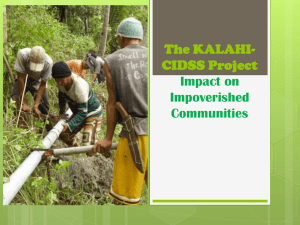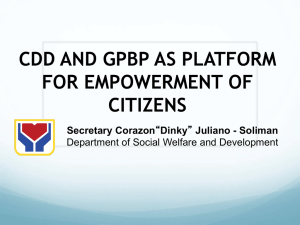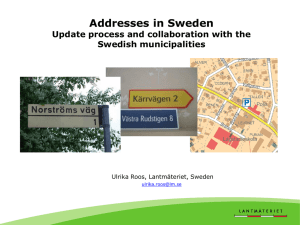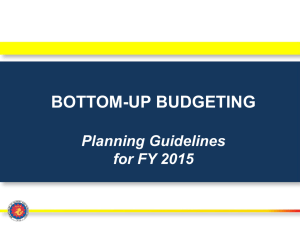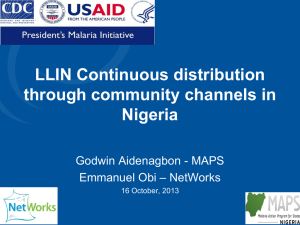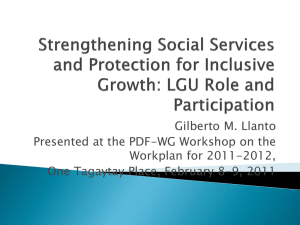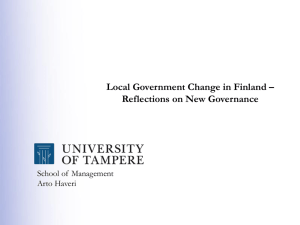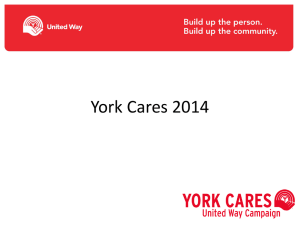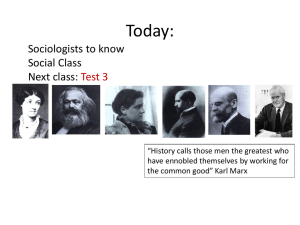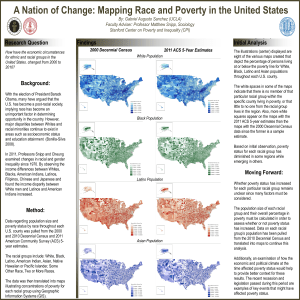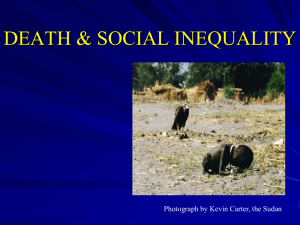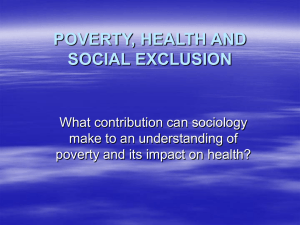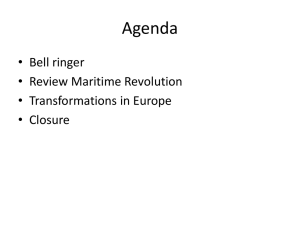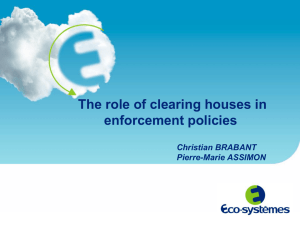2.2_Framework, Principles, Elements & Processes
advertisement
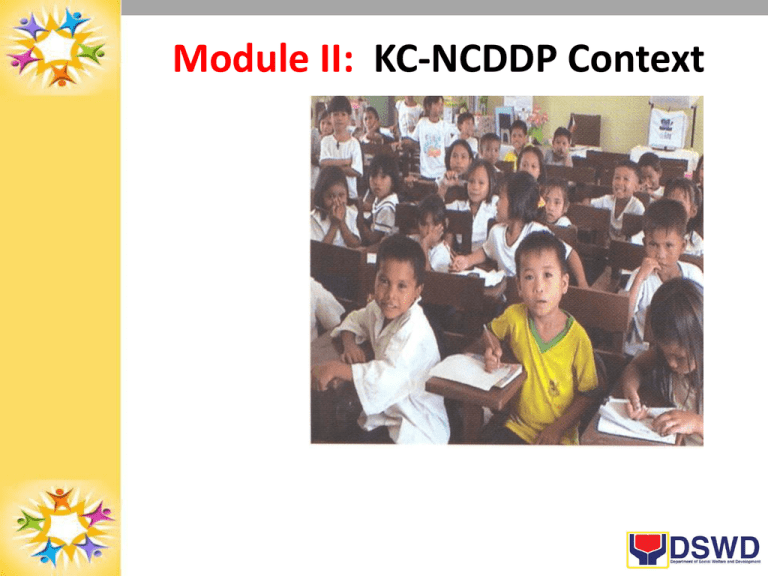
Module II: KC-NCDDP Context Session Objectives Session2.2.Framework, Principles, Elements and Processes 1. introduce CDD and history of KC 2. analyze the goal, objectives and principles, key elements, processes and components of KCNCDDP; 3. describe features of KC-NCDDP implementation; 4. explain results the KC-NCDDP is expected to accomplish; Session Objectives Session2.2.Framework, Principles, Elements and Processes 5. identify constraints or challenges which may hinder inclusive participation of vulnerable groups in KC-NCDDP ; 6. participation of vulnerable groups in KC-NCDDP ; 7. identify constraints or challenges which may hinder inclusive participation of vulnerable groups in KC-NCDDP ; 8. Demonstrate presentation skills to popularize KCNCDDP with various stakeholders. Session Topics Session2.2.Framework, Principles, Elements and Processes 1. KC-NCDDP - Objective, desired outcomes, indicators, policy-support 2. Program targeting criteria, areas and financing resources 3. LCC Requirements from LGUs and Communities 4. CDD Approach in a nutshell 5. Key elements, processes, and components of KC-NCDDP Outputs/KRAs • ACTs who can describe the goals, objectives/principles, and components of KC-NCDDP • ACTs who demonstrate high impact presentation skills • Outline of short demonstrations on presentation and facilitation skills Key Message 1 A. KC-NCDD Program is a means to achieve improved access to basic services and to participate in more inclusive local planning and budgeting. Key Message 2 B.KC-NCDDP assists poor communities to facilitate improvement of the wellbeing of their barangay and its residents. Key Message 3 C. Community-Driven Development (CDD) is a well-documented and tested approach which empowers communities to take control of the planning, implementing, and resource investments in their locality. Sub-Project sa Kalahi-CIDSS… Partsipasyon kag unity sang pumuluyo Hands-on experience sang pumuluyo Impluwensya sang kumunidad sa sa pagdesisyon Pangabudlay / Sakripisyo sang pumuluyo, brgy council volunteers, LGU-MIAC kagKC workers Resulta sang development dialogue/ sang kumunidad kag LGU Paghatag sang kumunidad sang pinansyal nga kontribusyon (LCC) THE KALAHI-CIDSS PROJECT Dealing the Roots of Poverty: New Frontiers in Region VI KC experience and Image.. • What are/were outcomes of the KALAHI-CIDDS intervention in your area? • From your experience, what techniques were effective in getting the barangay and municipality committee to KALAHI-CIDSS? • What do you expect to learn about KC-NCDDP at this training? Write three questions you wish answered. • What do you expect to learn bout KC-NCDDP at this training? Write three questions you wish answered. The KALAHI-CIDSS: A unique approach to development KALAHI-CIDSS is a GOP Poverty Reduction Project. It is one of the largest poverty alleviation portfolio of WB in the Philippines. • P9.3 billion total cost • P5.1 billion ($100 million) WB loan • P1.6 billion counterpart from GOP • P2.6 billion local counterpart •6 ½ year project (2003-2009) kalahi.dswd.gov.ph KALAHI-CIDSS Project Objectives • To Empower Communities • To Improve Local Governance • To Reduce Poverty Components • Social Prep, Capacity Building and Implementation Support • Grants for Community Projects • Monitoring and Evaluation kalahi.dswd.gov.ph Mapping the KC operational terrain for 2011-2015 KC-MT (11 eligible LGUs) KC-AF (16 and 14) KC-NCDDP (117 LGUs) KALAHICIDSS KC-JSDF (Urban Livelihood) KC-Gender Pilot (MCC) KC-PAMANA (OPAPP) KC-MCC (16 LGUS) KC-GOADFAT (School and DCC building) Kalahi-CIDSS-Millennium Challenge Corporation • $434 Philippine Compact – DSWD Kalahi-Cidss – DPWH Rehabilitation of Samar Rd. – DOF Computerization of collection system • KALAHI-CIDSS $120 • Expansion and Scaling-up • Aklan, Antique, Guimaras and Negros Occidental Our Portfolio in FO VI REGION VI PROJECT CY2014 Q1 BAL CY2014-Q2 TOTAL TARGET ACTUAL (Apr-June) Q2-BAL Q3-Q4 CUM BALANCE AF 7,102,568.75 - 7,102,568.75 3,531,340.53 3,571,228.22 - 3,571,228.22 MCC 102,208,638.46 73,592,423.15 175,801,061.61 36,974,469.43 138,826,592.18 34,451,346.59 173,277,938.77 AUSAID 3,125,452.47 - 3,125,452.47 - 3,125,452.47 - 3,125,452.47 GPB (3,292,760.00) 3,292,760.00 0.00 0.00 0.00 83,873,175.00 83,873,175.00 NCDDP - - - - - 823,015,980.00 823,015,980.00 TOTAL 109,143,899.68 76,885,183.15 186,029,082.83 40,505,809.96 145,523,272.87 941,340,501.59 1,086,863,774.46 Kapit-Bisig Laban sa KahirapanComprehensive and Integrated Delivery of Social Services National Community Driven Development Program KC-NCDDP development objective Communities in target municipalities are empowered to achieve improved access to basic services and to participate in more inclusive local planning and budgeting. KC-NCDDP program indicators • 40% of HHs report better access to services • 30% of HHs report increase in confidence to participate in community development activities • 50% of members from marginalized groups attend Barangay Assemblies Policy support for the KC-NCDDP • Philippine Development Plan (20112016) • Program of the National Anti-Poverty Commission (2010-2016) • Resolution of the Cabinet Cluster on Human Development and Poverty Reduction (HDPRC) • Endorsement of municipal governments (165 Mayors) KC-NCDDP and Phil. Dev’t. Plan (2011-16) “... social development programs shall adopt the CDD approach, where local communities take control in the planning, implementing and resource investments. CDD ensures that programs integrate the principles of local empowerment, participatory governance, demandresponsiveness, administrative autonomy, greater downward accountability and enhanced local capacity.” Targeting Criteria for Municipalities • 4th-6th class municipalities with PI higher than 26.5% national average (2009 NSCB SAE) • 1st-3rd class municipalities with poverty incidence 40% or over • Municipalities tagged as poor in the past, using previous KC poverty targeting • “Non-poor” municipalities affected by Typhoon Yolanda Indicative KC-NCDDP target areas (2014-19) • 5.4 million households • 19,697 barangays • 847 municipalities • 58 provinces Region No. of Target Municipalities CAR 49 I 11 III 3 IV-A 26 IV-MIMAROPA 67 V 101 VI 117 VII 107 VIII 136 IX 52 X 73 XI 27 XII 17 CARAGA 57 TOTAL 847 Components of KC-NCDDP’s Assistance to Targeted Poor Municipalities 1. Barangay grants 2. Capacity-building and implementation support (CBIS) 3. Program management and monitoring and evaluation (M&E) KC-NCDDP financing sources Local Funds External Financing • Philippine National Government • Local Government Units • Community Contributions Loans • World Bank WB) • Asian Development Bank (ADB) Grants • Department of Foreign Affairs and Trade (DFAT) • MCC • Other donors Financing for KC-NCDDP Financing Source A. GOP (national and local) and communities B. ADB Emergency Assistance Loan C. WB Loan Total Financing Amount in Million PhP 9,390 15,107 ($372.1M) 19,399 ($479M) 43.9 Billion LCC requirements from LGUs and communities Year 1 Required Counterpart Municipality Classification For Costs of the SubProjects 293 non-Yolanda-affected municipalities 1st to 3rd class municipalities 15% of MGA 4th to 6th class 5% of MGA 554 Yolanda-affected municipalities TA and Other Provisions LGU organic counterpart staff, office space, office furniture and equipment, computer, venue for related activities etc. Year 2 Onwards Total amount of KC-NCDDP and GPBP funding Required LCC for subprojects and TA Up to 100% of the LDF 10% of the LDF Over 100% up to 150% of the LDF 15% of the LDF Over 150% of the LDF 20% of the LDF Municipality Jamindan Ma-Ayon Tapaz Mambusao Panay Panitan Pilar Pontevedra Dao Dumalag Ivisan President Roxas Sapi-An Sigma 377 municipalities Dumarao Cuartero KC-NCDDP Portfolio in PROVINCE OF CAPIZ Typology Final Grant with top-up 1st-177 old 1st-177 old 1st-177 old 3rd-177 new 3rd-177 new 3rd-177 new 3rd-177 new 3rd-177 new 3rd-177 new 3rd-177 new 3rd-177 new 3rd-177 new 3rd-177 new 3rd-177 new 13,650,780.00 14,207,700.00 18,739,890.00 14,692,080.00 16,945,110.00 14,779,050.00 16,213,080.00 16,974,750.00 20,423,040.00 18,750,720.00 17,128,320.00 18,279,040.00 15,858,560.00 18,648,320.00 2nd-377 old 3rd-377 new 26,391,600.00 20,364,800.00 KC-NCDDP builds upon the KC 10-yr experience One of three Philippine government pro-poor programs implemented through the DSWD, KALAHICIDSS (the Kapit-Bisig Laban sa KahirapanComprehensive and Integrated Delivery of Social Services) is the largest community-driven development (CDD) project in the country. What is Community Driven Development (CDD)? who are assisted with access to information, capacity building, and engagement with local governments and other partners Desired outcomes of CDD Improved HHs Access to Basic Services, and Good Governance Communities: identify poverty challenges identify project solutions and actions to poverty challenges exercise control of resources for community projects partner with LGUs, NGAs and CSOs (carried over to the KC-NCDDP) Key elements of KALAHI-CIDSS • Community-led development process, from analysis and planning to implementation and maintenance • Significant investments in building community capacity • Open menu system of projects (with negative list) • Funds released directly to community • Community management of funds • Multi-level monitoring and evaluation • Grievance Redress System (GRS) 11,269 community projects worth PhP11.7 billion serving 2.5M households to date. KC-NCDDP in a nutshell 1. Affirmative Action to accelerate poverty reduction in poorest municipalities with diverse needs and contexts. 2. Links communities and LGUs to national agencies and central decision-making. 3. Expeditious transfer of larger resources to targeted communities and transparent use of funds to support targeted pro-poor projects. 4. Supports post-disaster response and development of Yolanda-affected areas. 5. Approved by NEDA Board in January 2013. 6. Target launch in 2nd semester of 2014. Convergence of government services - a major KC-NCDDP strategy KC-NCDDP Convergence Principles • Eliminate duplication and wastage • Ensure complementation of investments • Reinforce existing planning and coordinative mechanisms • Decentralize decision-making. Reflection Questions 1. After going through in those slides, how do you feel about KC-NCDDP? 2. How do you feel about being part of the team which will bring this earth-shaking change to the lives of 5.4 million Filipinos especially those who have not had many opportunities to benefit from the fruits of social development programs- women, indigenous peoples, and natural disaster victims? Application – Presenting and Facilitating Skills Practice ACT facilitating an orientation of KC-NCDDP: 1. AC presenting KC-NCDDP objectives, and principles, project components, funding sources to SB members 2. CF presenting CDD concepts to Barangay council Skills Demonstration 1. Preparation time – 20 minutes 2. Teaching time 10 minutes – Refer to Demonstration Teaching Feedback Sheet 3. Team may team-teach or select one or two members to teach and facilitate the 10-minute session. 4. Read Handout #2 Tips for Facilitators Topics for Teaching Demonstration 1. KC-NCDDP – Objective and policy-support 2. KC-NCDDP targeting criteria, areas and financing resources 3. LCC Requirements from LGUs and Communities 4. CDD Approach - Desired outcomes 5. Key elements KC-NCDDP carried over from KALAHI-CIDSS 6. KC-NCDDP components to assist targeted poor municipalities Tips for Facilitators 1. Prepare and organize procedures, materials and facilities needed to conduct the discussion. 2. Introduce, end, and tie together the experiences involved in the discussion. 3. Announce and monitor discussion time. 4. Restate and call attention to the main purpose or topic. Tips for Facilitators (Continuation) 5. Remind participants to – – Share only one idea in few sentences. – Give all members of the group the opportunity to speak. – Do not monopolize the discussion. – Maintain a positive tone during the discussion. 6. Stimulate, guide, encourage participation especially by the “more shy” members. 7. Set a climate of discovery, acceptance, openness, and trust so participants will be encouraged to learn new concepts, try out new skills and improve competence. 8. Be enthusiastic, model the skills being taught. Tips for Facilitators (Continuation) 9. Know and understand the material well. 10. Be sensitive to the differences in participation, needs, and learning styles of the participants. 11. Acknowledge or reinforce contributions/ideas which are correct. 12. Summarize three or four most significant points raised during the discussion. 13. Enjoy and make sure you also learn and benefit from the experience. 14. A facilitator is a process manager, not a participant in a discussion. Tips for Giving Winning Presentations 1. Relax; show your confidence with a smile as you approach the podium. 2. Start off with as much impact as possible. Present a challenge or recall a story that will move your audience. 3. Keep the presentation to the point. Don’t cover materials the audience already knows. Tips for Giving Winning Presentations 4. Do not read word for word from your notes, slides, or charts. 5. Keep eye contact with your audience. 6. Keep people’s attention. 7. Use humor only if you are good at telling jokes. Tips for Giving Winning Presentations 8. Involve your audience. 9. Use teaching aids to add impact. End with a challenge that leaves the audience with something to think about. True and False Test 1. 2. 3. 4. 5. KC-NCDDP will be implemented for six years, 20142019. KC-NCDDP is aimed to improve the well-being of target barangays and its residents. CDD ensures that programs integrate the principles of local empowerment, participatory governance, demand-responsiveness, administrative autonomy, greater downward accountability and enhanced local capacity. KC-NCDDP or KALAHI-CIDSS National CDD Program is a massive employment program designed for poor municipalities. All participating municipal governments and barangays are expected to promote active participation of men and women in decision-making within the opportunities provided in KC-NCDDP. True and False Test 6. Several successful strategies from KALAHI-CIDSS have been carried over to KC-NCDDP including community-led development process, direct release of funds to participating communities, and community management of funds. 7. Three desired outcomes of CDD are: service delivery, LGU efficiency, and poverty reduction. 8. KC-NCDDP will incorporate development themes including the promotion of gender equity, disaster preparedness and mitigation, affirmative action for Indigenous Peoples, and peace-building in communities affected by armed conflict. 9. Convergence of government services is an intrinsic component of the KC-NCDDP strategy. 10. KC-NCDDP is designed to alleviate poverty only in rural communities especially those devastated by Typhoon Yolanda.
